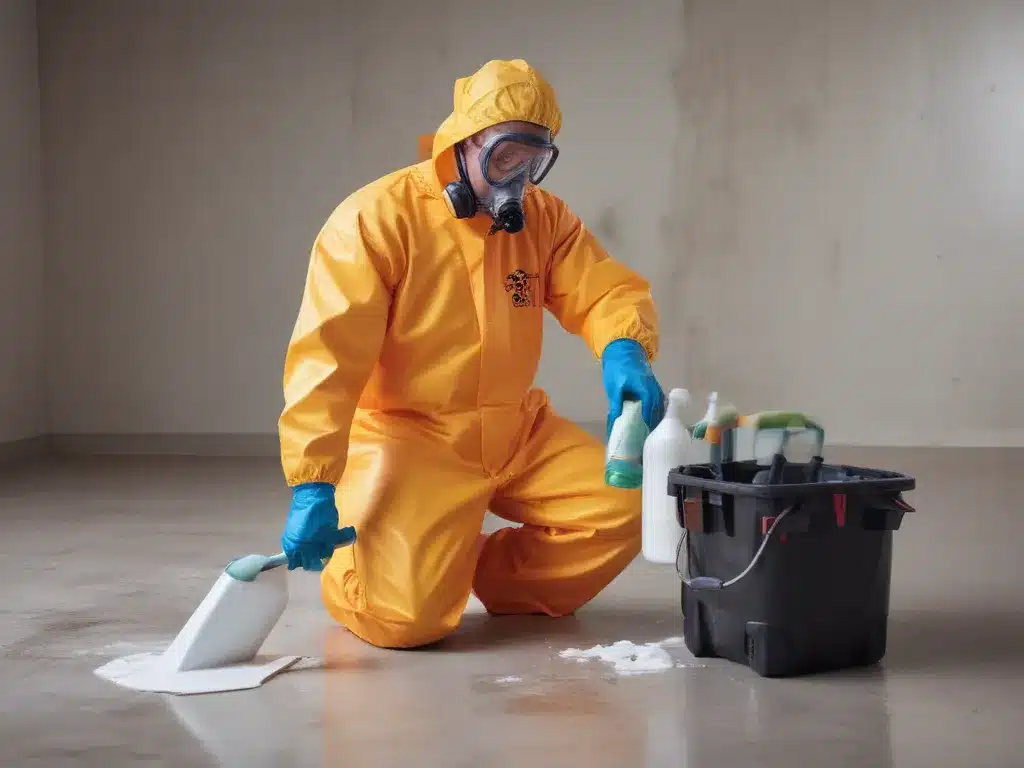Introduction
As a professional cleaning service provider, I understand the importance of safe chemical cleanup. Hazardous materials pose a significant risk to human health and the environment, and their proper handling and disposal are crucial. In this article, I will provide a comprehensive guide on safe chemical cleanup, covering various aspects such as identifying hazardous substances, personal protective equipment (PPE), proper disposal methods, and regulatory compliance.
Understanding Hazardous Substances
The first step in safe chemical cleanup is identifying the hazardous substances present. Hazardous substances can be classified into different categories based on their physical and chemical properties, including:
- Flammable substances – These substances have a low flash point and can easily ignite, posing a fire risk. Examples include solvents, gasoline, and certain cleaning products.
- Corrosive substances – These substances can cause severe damage to living tissues and materials upon contact. Examples include acids, bases, and certain cleaning products.
- Toxic substances – These substances can cause adverse health effects, ranging from mild irritation to severe illness or even death. Examples include heavy metals, pesticides, and certain industrial chemicals.
- Reactive substances – These substances can undergo violent chemical reactions when exposed to certain conditions or other substances. Examples include unstable compounds and oxidizing agents.
Proper identification of hazardous substances is crucial for determining the appropriate safety measures and disposal methods.
Personal Protective Equipment (PPE)
When dealing with hazardous substances, personal protective equipment (PPE) is essential for minimizing exposure and preventing potential harm. The specific PPE required will depend on the nature of the hazardous substance and the tasks involved in the cleanup process. Common PPE for chemical cleanup includes:
- Respiratory protection – Respirators or air-purifying respirators may be necessary to protect against inhalation of toxic fumes or vapors.
- Eye and face protection – Goggles, face shields, or safety glasses are required to protect against splashes or vapors that can irritate or damage the eyes and face.
- Protective clothing – Chemical-resistant suits, aprons, or coveralls provide a barrier against skin contact with hazardous substances.
- Hand protection – Chemical-resistant gloves are essential for preventing skin absorption and chemical burns.
- Foot protection – Chemical-resistant boots or shoe covers protect against spills and potential chemical contact with the feet.
It is crucial to select the appropriate PPE based on the specific hazards present and ensure that it is properly fitted and maintained.
Proper Disposal Methods
Once hazardous substances have been identified and contained, proper disposal methods must be followed to minimize environmental impact and comply with regulations. The disposal methods will vary depending on the type and quantity of hazardous substances involved. Some common disposal methods include:
- Landfill disposal – For some hazardous wastes, landfill disposal may be an option, but it is subject to strict regulations and requirements.
- Incineration – Certain hazardous wastes can be safely incinerated at high temperatures, effectively destroying the hazardous components.
- Chemical treatment – Some hazardous substances can be chemically treated to neutralize or stabilize them before disposal.
- Recycling or recovery – Certain hazardous materials can be recycled or recovered for reuse, reducing waste and environmental impact.
It is important to consult with waste management professionals and follow all applicable regulations to ensure safe and compliant disposal of hazardous substances.
Regulatory Compliance
Chemical cleanup and hazardous waste disposal are heavily regulated to protect human health and the environment. Failure to comply with regulations can result in severe penalties and legal consequences. Some key regulatory bodies and requirements to consider include:
- Environmental Protection Agency (EPA) – The EPA enforces various regulations related to hazardous waste management, including the Resource Conservation and Recovery Act (RCRA) and the Comprehensive Environmental Response, Compensation, and Liability Act (CERCLA).
- Occupational Safety and Health Administration (OSHA) – OSHA sets standards for worker safety and training requirements for handling hazardous substances in the workplace.
- Department of Transportation (DOT) – The DOT regulates the transportation of hazardous materials, including packaging, labeling, and documentation requirements.
- State and local regulations – Many states and localities have additional regulations and requirements for hazardous waste management and chemical cleanup.
It is essential to stay up-to-date with the latest regulations and ensure compliance at all stages of the chemical cleanup process.
Real-World Examples and Case Studies
To illustrate the importance of safe chemical cleanup, let’s explore a few real-world examples and case studies:
-
Industrial chemical spill – In 2014, a major chemical spill occurred at a manufacturing facility in West Virginia, contaminating the local water supply. Proper containment, cleanup, and disposal procedures were crucial in minimizing the environmental and public health impact.
-
Methamphetamine lab cleanup – The cleanup of illegal methamphetamine labs involves dealing with a variety of hazardous substances, including volatile solvents, corrosive acids, and toxic precursor chemicals. Specialized training and strict safety protocols are necessary for these types of cleanups.
-
Asbestos abatement – Asbestos, a known carcinogen, was commonly used in building materials until the late 20th century. Asbestos abatement and cleanup require specialized techniques and equipment to prevent the release of hazardous fibers into the air.
These examples highlight the importance of adhering to safe chemical cleanup practices and the potential consequences of improper handling or disposal of hazardous substances.
Conclusion
Safe chemical cleanup is a critical aspect of protecting human health and the environment. By understanding hazardous substances, utilizing proper personal protective equipment, following appropriate disposal methods, and complying with regulations, we can minimize the risks associated with hazardous materials. As a professional cleaning service provider, I prioritize safety and adhere to industry best practices to ensure the well-being of our clients and the communities we serve. If you require assistance with biohazard or hazardous material cleanup, please visit https://adamcleaning.uk/biohazard-cleaning/ for more information on our specialized services.







